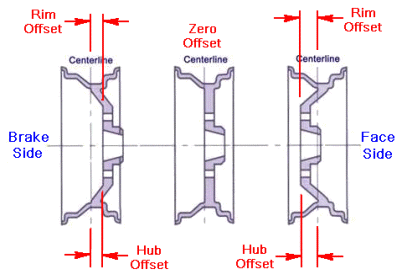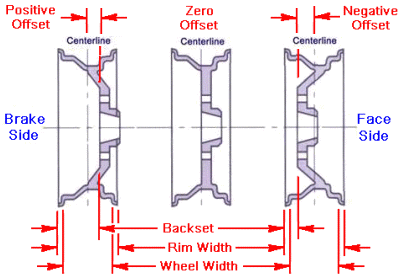The MGA With An Attitude
WHEEL OFFSET Clarified - WL-200
If you are reading this page you may already be concerned about a difference of opinion about what is called "Positive" or "Negative" wheel offset. I have revised a couple of web pages already for clarification (mostly trying to remove any reference to positive or negative), but the argument persists. I believe the confusion stems from a change of view over the years where some of us are still stuck in the 50's and 60's while the world has moved on to something else. So I will take this opportunity to ramble a bit about history and viewpoint. First a diagram of what's causing the controversy.

My own experience starts in the 1950's when most cars in North America were rear wheel drive and BIG and had wheels with no offset. Having the centerline of the rim coincide with the bolt-on surface makes for the least stress on a wheel when a car is traveling in a straight line hitting bumps and pot holes, which is the way most cars do most of their travel mileage. In the total life of a vehicle, the time a car spends with the front wheels pointed anywhere other than straight ahead is a very small part of the vehicle life (maybe less than 1%).
In those days it was common when "hot rodding" cars to install wheels with a substantial offset to provide a wider wheel base for better stability, or to allow installation of wide wheels and tires without interfering with inboard chassis or suspension parts. These were simply called "offset" wheels with no reference to positive or negative. Wire wheels in particular have a wide central splined hub, so the flat inboard hub surface (next to the brake drum) is substantially inboard from the rim centerline, so much so that the rear axle is built shorter to maintain the desired track width. It was very unusual to find any wheels offset in the other direction (except a few of those "little import cars").
With the advent of front wheel drive cars and independent rear suspension there was a problem with minimal length of the lateral drive shafts. This brought the need to introduce dished wheels with the center hub set substantially outboard. Since the wheel rim and tire were to be set inboard from the mounting surface it would be called "inset", which was commonly explained as "negative offset". The world would be less confusing if we still used the terms "offset" and "inset" with no reference to positive or negative.
Let the automotive world evolve another 40 or 50 years and we have more front drive cars than rear drive cars. These days it is more common to see small cars and cars with front drive and independent rear suspension or all-wheel drive. Now it is less common to see zero offset, and generally uncommon to see wheels going the other direction. As such, people wishing to ignore the reference to positive or negative will usually be comparing offset of one dished wheel to another dished wheel, and going the other direction is rare and uncommon, so they would call that "negative". Now to justify the new view of which direction is positive or negative they switch to referring to the direction of hub offset rather than the rim. Positive offset is still outboard, but now they are referring to the hub offset rather than the rim offset (very convenient).
Not confused enough yet? Another way of measuring wheels is to refer to "backset". Backset is the distance from the inboard rim edge to the bolt-on mounting surface of the hub. Lay a straight edge across the inner rim and measure to the mounting surface, and you get backset as a direct measurement. Measuring across the full width of the rim gives you "rim width". Measuring in between the tire bead mount surfaces gives a consistent measurement of what is ALWAYS referred to as "wheel width". You can easily convert measured overall width and backset measurements to offset dimension by the formula B-(W/2). Rim edge design makes no difference, as W/2 is always the centerline of the rim regardless. The result may be positive or negative depending on wheel shape.
Once you understand how all this works there is no confusion at all about offset, only whether people refer to it as positive or negative. This is why anyone referring to these dimensions as positive or negative will always have to explain which direction they are calling positive. This is one issue that may never be consolidated to one standard in the "political" world. However, by now most wheel suppliers have settled fairly consistently on the newer point of view and refer to outset hubs and inset rims as "Positive Offset". So here is the new diagram with the modern terminology.

|

